Science and research programs can bring millions of dollars to college campuses in the form of alumni donations and research grants. While these dollars may result in state of the art facilities, they do not always mean that science labs are housed in beautiful new buildings. Many science labs are more practical than they are attractive, and the fun, cutting-edge architecture on campus may be saved for theaters, student unions, and other facilities.
Of course, that’s not the case on every campus, and there are some colleges and universities that boast some pretty amazing buildings for their laboratories. Here, we’ve compiled a list of some of the coolest, most interesting, and newest science laboratories across the nation, though it is by no means a definitive account of all that are out there. Seeing and learning more about these buildings may just make you want to sign up for a science class of your own so you can hang out in one.
-
Oxford Inorganic Chemistry Labs
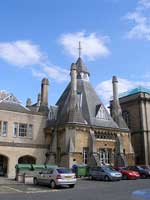 Oxford may just boast one of the oldest purely inorganic chemistry labs in the world. Its famous “Abbot’s Kitchen,” modeled after the real Abbot’s kitchen in Glastonbury Abbey, was built in 1860 and still stands on the campus today. The small, octagonal structure was built in gothic style, as were the many additions that labs received over the decades. In 1957, a huge, new and decidedly modern wing was built (dwarfing the original lab) and today the laboratories, both old and new, have combined to create the biggest school of inorganic chemistry in the UK.
Oxford may just boast one of the oldest purely inorganic chemistry labs in the world. Its famous “Abbot’s Kitchen,” modeled after the real Abbot’s kitchen in Glastonbury Abbey, was built in 1860 and still stands on the campus today. The small, octagonal structure was built in gothic style, as were the many additions that labs received over the decades. In 1957, a huge, new and decidedly modern wing was built (dwarfing the original lab) and today the laboratories, both old and new, have combined to create the biggest school of inorganic chemistry in the UK. -
MIT Media Lab
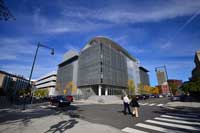 MIT’s Media Lab is home to research in subjects like biomechatronics, cognitive machines, digital intuition, new media medicine and even opera of the future. Such cutting-edge research, especially that drawing on so many disciplines, requires a multi-functional and equally cutting edge space — and that’s just what students and researchers at MIT’s Media Lab have. The building was designed by Pritzker Prize-winning architect Fumihiko Maki, and features an open and highly adaptable interior structure that is ideal for encouraging groups from varying fields to work together and collaborate on any work they do in the lab.
MIT’s Media Lab is home to research in subjects like biomechatronics, cognitive machines, digital intuition, new media medicine and even opera of the future. Such cutting-edge research, especially that drawing on so many disciplines, requires a multi-functional and equally cutting edge space — and that’s just what students and researchers at MIT’s Media Lab have. The building was designed by Pritzker Prize-winning architect Fumihiko Maki, and features an open and highly adaptable interior structure that is ideal for encouraging groups from varying fields to work together and collaborate on any work they do in the lab. -
Mallinckrodt Laboratory, Harvard University
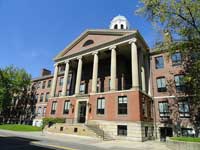 The Mallinckrodt building is home to Harvard’s chemistry department, or at least a part of it, and features not only lecture halls, but a wide range of labs that offer high-tech resources like scanning probe microposy. The lab, with its stately neoclassical pediments and columns, was built in the 1920s through a gift from alumnus Edward Mallinckrodt, who had gone one to start a highly successful pharmaceutical business after graduating from the school.
The Mallinckrodt building is home to Harvard’s chemistry department, or at least a part of it, and features not only lecture halls, but a wide range of labs that offer high-tech resources like scanning probe microposy. The lab, with its stately neoclassical pediments and columns, was built in the 1920s through a gift from alumnus Edward Mallinckrodt, who had gone one to start a highly successful pharmaceutical business after graduating from the school. -
Frick Chemistry Laboratory, Princeton University
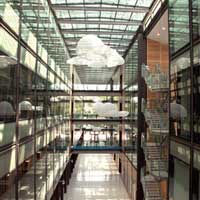 Frick Laboratory at Princeton was designed by Payette Associates of Boston. It is largely constructed of glass, allowing large amounts of light into classroom spaces and the building’s jaw dropping atrium. Not only in the space open and light-filled, but labs and offices are visible through glass on both sides of the structure, with the aim of fostering greater transparency and collaboration between groups at the school. The icing on the cake is a sculpture by artist Kendall Buster, which hands throughout the middle of the atrium looking like clouds that have floated indoors.
Frick Laboratory at Princeton was designed by Payette Associates of Boston. It is largely constructed of glass, allowing large amounts of light into classroom spaces and the building’s jaw dropping atrium. Not only in the space open and light-filled, but labs and offices are visible through glass on both sides of the structure, with the aim of fostering greater transparency and collaboration between groups at the school. The icing on the cake is a sculpture by artist Kendall Buster, which hands throughout the middle of the atrium looking like clouds that have floated indoors. -
Syracuse Center of Excellence
 The Syracuse Center of Excellence isn’t exclusively a university building, though many researchers and academics from Syracuse University use the labs for work. The building, partially funded by the University, is meant to be a collaborative space for those both in academia, industry, and business to come together to work on environmentally friendly solutions in energy innovation and conserving water resources, along with a wide range of other green issues. The building itself is impressive in that respect, serving as a model of how to do LEED right by achieving platinum certification. Sleek, beautiful and wholly modern, the building zig-zags glass and metal throughout the dozens of labs that it houses, creating a beautiful setting for researchers to come up with the next great green innovation.
The Syracuse Center of Excellence isn’t exclusively a university building, though many researchers and academics from Syracuse University use the labs for work. The building, partially funded by the University, is meant to be a collaborative space for those both in academia, industry, and business to come together to work on environmentally friendly solutions in energy innovation and conserving water resources, along with a wide range of other green issues. The building itself is impressive in that respect, serving as a model of how to do LEED right by achieving platinum certification. Sleek, beautiful and wholly modern, the building zig-zags glass and metal throughout the dozens of labs that it houses, creating a beautiful setting for researchers to come up with the next great green innovation. -
Jennie Lee Building, Open University
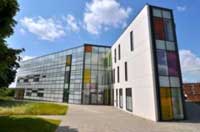 Completed in 2008, the Jennie Lee Building on the Open University’s Milton Keynes campus houses many of the school’s high-tech research laboratories working to better understand and design for interactions between humans and ambient technologies. The building itself offers up some ambient tech, with intelligent control systems and embedded technology throughout the building’s main atrium. Meant to be a showcase for cutting-edge research at the school, the building delivers, with multi-colored glass, green innovations, and adaptable spaces for collaboration inside.
Completed in 2008, the Jennie Lee Building on the Open University’s Milton Keynes campus houses many of the school’s high-tech research laboratories working to better understand and design for interactions between humans and ambient technologies. The building itself offers up some ambient tech, with intelligent control systems and embedded technology throughout the building’s main atrium. Meant to be a showcase for cutting-edge research at the school, the building delivers, with multi-colored glass, green innovations, and adaptable spaces for collaboration inside. -
Earth and Space Exploration Labs, Arizona State University
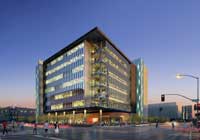 The Earth and Space Exploration Labs at ASU house some serious scientific equipment for studying the makeup of both our own planet and others throughout our solar system and galaxy. The building is still under construction but is slated to be completed early in 2012. The progressive structure will stand seven stories tall, employ a wide range of smart and LEED certified technology, and will ultimately be the largest research facility ever built on the ASU campus. Designed by Ehrlich Architects, the building, like many others on this list, was created with transparency in mind. Students and researchers can expect to see a lot of glass, both inside and out, helping to create an environment where collaboration is encouraged and accessible.
The Earth and Space Exploration Labs at ASU house some serious scientific equipment for studying the makeup of both our own planet and others throughout our solar system and galaxy. The building is still under construction but is slated to be completed early in 2012. The progressive structure will stand seven stories tall, employ a wide range of smart and LEED certified technology, and will ultimately be the largest research facility ever built on the ASU campus. Designed by Ehrlich Architects, the building, like many others on this list, was created with transparency in mind. Students and researchers can expect to see a lot of glass, both inside and out, helping to create an environment where collaboration is encouraged and accessible. -
Ryerson Physical Laboratory, University of Chicago
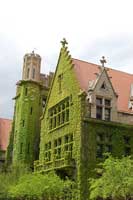 The historic campus of the University of Chicago is a Gothic wonderland, with block after block of ivy-covered buildings. One of these is Ryerson Physical Laboratory, the home of many of the school’s physics department labs, which was built at the turn of the 20th century through a gift from Martin A. Ryerson. This gorgeous old building doesn’t just look nice, however, it’s also a historic physics site. In 1909, Robert Millikan performed the famous oil-drop experiment in the building, allowing him to calculate the charge of an electron and ultimately win the Nobel Prize in physics. It was also home to two other Nobel winners and their research, A.A. Michelson and Arthur H. Compton, helping make it one of the most famous physical laboratories in the United States.
The historic campus of the University of Chicago is a Gothic wonderland, with block after block of ivy-covered buildings. One of these is Ryerson Physical Laboratory, the home of many of the school’s physics department labs, which was built at the turn of the 20th century through a gift from Martin A. Ryerson. This gorgeous old building doesn’t just look nice, however, it’s also a historic physics site. In 1909, Robert Millikan performed the famous oil-drop experiment in the building, allowing him to calculate the charge of an electron and ultimately win the Nobel Prize in physics. It was also home to two other Nobel winners and their research, A.A. Michelson and Arthur H. Compton, helping make it one of the most famous physical laboratories in the United States. -
Warren and Katharine Schlinger Laboratory for Chemistry and Chemical Engineering, Caltech
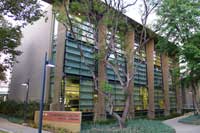 This new building on Caltech’s campus more closely resembles a performing arts center than a haven of scientific research, but that may have been what the school was aiming for in getting a truly cutting-edge facility. The high-tech building boasts a number of LEED features, and was designed with the comfort and safety of students and researchers in mind, offering lots of natural light and flexible lab spaces. Even better, many of the labs have views of the surrounding mountains, making for a pretty inspirational place to conduct any kind of research.
This new building on Caltech’s campus more closely resembles a performing arts center than a haven of scientific research, but that may have been what the school was aiming for in getting a truly cutting-edge facility. The high-tech building boasts a number of LEED features, and was designed with the comfort and safety of students and researchers in mind, offering lots of natural light and flexible lab spaces. Even better, many of the labs have views of the surrounding mountains, making for a pretty inspirational place to conduct any kind of research. -
Physical Sciences Labs, Cornell University
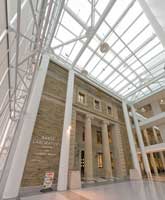 When the physical sciences outgrew their building on Cornell’s campus, the university decided to expand, simply butting the new, highly modern structure right up to the edge of the older, Neoclassically designed Baker Laboratory. While it might sound awkward, the results are pretty impressive. It doesn’t hurt that the new structure is a pretty awesome work of architecture, however. Researchers in the building get to enjoy the fruits of work to earn LEED Gold certification as well as lots of light, open common spaces, and more than 88 state of the art labs.
When the physical sciences outgrew their building on Cornell’s campus, the university decided to expand, simply butting the new, highly modern structure right up to the edge of the older, Neoclassically designed Baker Laboratory. While it might sound awkward, the results are pretty impressive. It doesn’t hurt that the new structure is a pretty awesome work of architecture, however. Researchers in the building get to enjoy the fruits of work to earn LEED Gold certification as well as lots of light, open common spaces, and more than 88 state of the art labs.
No comments:
Post a Comment